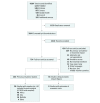Prevalence and Estimated Economic Burden of Substandard and Falsified Medicines in Low- and Middle-Income Countries: A Systematic Review and Meta-analysis
- PMID: 30646106
- PMCID: PMC6324280
- DOI: 10.1001/jamanetworkopen.2018.1662
Prevalence and Estimated Economic Burden of Substandard and Falsified Medicines in Low- and Middle-Income Countries: A Systematic Review and Meta-analysis
Abstract
Importance: Substandard and falsified medicines burden health systems by diverting resources to ineffective or harmful therapies, causing medical complications and prolonging illnesses. However, the prevalence and economic impact of poor-quality medicines is unclear.
Objective: To conduct a systematic review and meta-analysis to assess the prevalence and estimated economic burden of substandard and falsified essential medicines in low- and middle-income countries.
Data sources: Five databases (PubMed, EconLit, Global Health, Embase, and Scopus) were searched from inception until November 3, 2017.
Study selection: Publications were assessed to determine whether they examined medicine quality and the prevalence and/or economic burden of substandard and falsified medicines in low- and middle-income countries. Studies with a sample size of 50 or more were included in the meta-analysis.
Data extraction and synthesis: The study is registered in PROSPERO and reported via the Preferred Reporting Items for Systematic Reviews and Meta-analyses (PRISMA) reporting guidelines. Study quality was assessed using an adapted Medicine Quality Assessment Reporting Guidelines scoring metric. Multiple reviewers conducted the data extraction and quality assessment independently.
Main outcomes and measures: Prevalence and/or estimated economic impact of substandard and falsified medicines.
Results: Two hundred sixty-five studies that estimated the prevalence of poor-quality essential medicines in low- and middle-income countries were identified. Among 96 studies that tested 50 samples or more (67 839 total drug samples), overall prevalence of poor-quality medicines was 13.6% (95% CI, 11.0%-16.3%), with regional prevalence of 18.7% in Africa (95% CI, 12.9%-24.5%) and 13.7% in Asia (95% CI, 8.2%-19.1%). Of studies included in the meta-analysis, 19.1% (95% CI, 15.0%-23.3%) of antimalarials and 12.4% (95% CI, 7.1%-17.7%) of antibiotics were substandard or falsified. Eight approximations of the economic impact, focused primarily on market size, with poor or undisclosed methods in estimation were identified, ranging from $10 billion to $200 billion.
Conclusions and relevance: Poor-quality essential medicines are a substantial and understudied problem. Methodological standards for prevalence and rigorous economic studies estimating the burden beyond market size are needed to accurately assess the scope of the issue and inform efforts to address it. Global collaborative efforts are needed to improve supply-chain management, surveillance, and regulatory capacity in low- and middle-income countries to reduce the threat of poor-quality medicines.
Trial registration: PROSPERO Identifier: CRD42017080266.
Conflict of interest statement
Figures



Comment in
-
Prevalence of Substandard and Falsified Essential Medicines: Still an Incomplete Picture.JAMA Netw Open. 2018 Aug 3;1(4):e181685. doi: 10.1001/jamanetworkopen.2018.1685. JAMA Netw Open. 2018. PMID: 30646099 No abstract available.
References
-
- World Health Organization Health in 2015: From MDGs, Millennium Development Goals to SDGs, Sustainable Development Goals. Geneva, Switzerland: World Health Organization; 2015.
-
- Kaplan W, Mathers C. The World Medicines Situation 2011: Health Trends: Global Burden of Disease and Pharmaceutical Needs. Geneva, Switzerland: World Health Organization; 2011.
-
- World Health Organization A Study on the Public Health and Socioeconomic Impact of Substandard and Falsified Medical Products. Geneva, Switzerland: World Health Organization; 2017.
Publication types
MeSH terms
Substances
LinkOut - more resources
Full Text Sources
Medical

